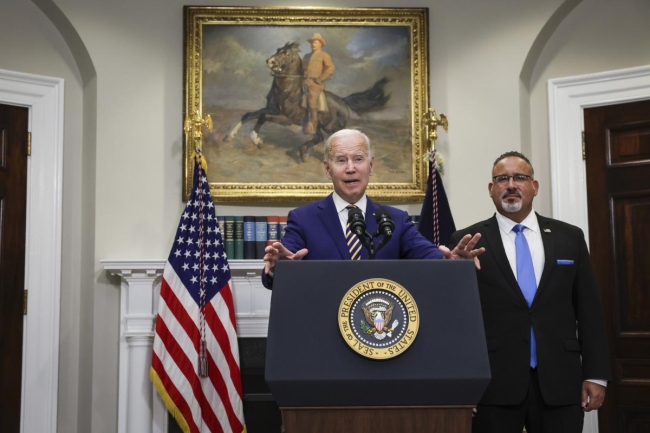You have /5 articles left.
Sign up for a free account or log in.

President Biden and Secretary Cardona
Alex Wong/Getty Images
While President Biden’s one-time student loan forgiveness plan remains tied up in the U.S. Supreme Court, the Education Department is working on a more far-reaching and costly plan to overhaul how people pay back their loans.
The overhaul of the department’s income-driven repayment program, which bases monthly payments on an individual’s income and family size, would cut payments in half for undergraduates, with a cap of 5 percent on a borrower’s discretionary income. Those who take out $12,000 or less in loans would qualify for relief in 10 years, among other changes. Over all, experts say this plan has the potential to remake how higher education is financed in America—though that depends on whether borrowers take advantage of it.
“It won’t be overnight,” said Jason D. Delisle, a senior policy fellow at the Urban Institute’s Center on Education Data and Policy. “I think it will take a while for people to realize this change.”
But once borrowers get wise, Delisle thinks more college students will take out student loans because the terms are more advantageous.
The broad strokes of the administration’s plan for income-driven repayment were released in August at the same time that Biden announced he would forgive up to $20,000 in federal student loans for eligible Americans. The department is expected to release a draft of the regulations for the income-contingent program’s changes within the next month, kicking off what will likely be the next front of partisan war over student loan forgiveness.
Department officials have said they are “excited” about the income-driven repayment changes, which Biden touted as a “game changer” in August. Likewise, experts and debt-relief advocates say the changes are significant, in that they’ll apply to past, present and future borrowers and are likely more resilient to court challenges.
“The IDR changes are on a much stronger legal footing,” said Kevin Carey, vice president for education policy at New America, a think tank. “The Obama administration has already done this, but no one challenged it in court.”
The legal fight has thus far focused on the one-time debt relief, though Republican lawmakers have criticized the income-driven repayment changes as well.
North Carolina Republican representative Virginia Foxx, who will lead the House Committee on Education and Labor next year, said the administration’s plans would increase the cost of the income-driven repayment program and “upend the integrity of the federal student loan program.”
“These changes will have long-term consequences because they create perverse incentives for overborrowing,” Foxx said Tuesday on the House floor. “Why would students make smart financial decisions when they know Uncle Joe, or another administration, will pay off their loans? Instead of solving the problem for all borrowers, President Biden is sticking future borrowers in a ship with cracks in the hull.”
She added that the “foolhardy changes” would fuel increases in the cost of college.
“With taxpayer-subsidized tuition, colleges and universities will have no incentives to keep costs down,” she said. “It will also turn more postsecondary institutions into degree mills. The only thing loan forgiveness does is encourage colleges and universities to offer even more degree programs they know do not pay off once students enter the workforce.”
What’s Changing
In the income-driven repayment program, which began in the 1990s, borrowers’ monthly payments are calculated based on their income and family size. After making payments for 20 to 25 years, depending on the specific plan, a borrower’s remaining balance is forgiven. About one-third of borrowers have opted in to income-driven repayment. Critics have argued that the monthly payments are still unaffordable for some borrowers and that it’s a difficult program to access and remain enrolled in.
The Student Borrower Protection Center and the National Consumer Law Center found last year that just 32 borrowers had their balances canceled through income-driven repayment since the program began.
The changes unveiled in August were aimed at simplifying the program and making it fairer. Under the proposal, the first $30,500 that a single individual with no dependents makes will be exempt from the payment calculation. Currently, an individual’s discretionary income is the difference between their annual income and 150 or 100 percent of the federal poverty level, depending on the specific repayment plan. The administration is proposing to protect up to 225 percent of the federal poverty level from repayment. Additionally, borrowers won’t see their balances grow as long as they make monthly payments.
“It changes every feature of the program in a way that makes it much more generous—far beyond anything I’ve proposed or recommended,” Delisle said.
Delisle said the proposed changes could turn federal student loans into partial grants for those with an associate degree or certificate, which could lead to more borrowing.
“I think this is going to create a real dilemma for community colleges,” he said. “Right now, they kind of discourage students from taking loans, or they may just not participate in the loan program. But this is such a large source of money that I think that’s going to change that calculus.”
Other experts say the plan could become another way to make community college sort of free—one of Biden’s policy priorities. Community college students tend to have lower balances, and the White House estimated that forgiving balances after 10 years for this group would allow nearly all of community college borrowers to be debt-free after 10 years. Plus, by increasing the percentage of income protected from the calculation, community college students could pay little or nothing in monthly payments for those 10 years.
Carey at New America recently wrote about how the proposed version of income-driven repayment could translate to free community college. In an interview, he said that one barrier will be the “substantial debt aversion among community college students.”
“The more skepticism of it, the less it functions as a true replacement for a free community college,” he said. “The less skepticism … the more expensive and the bigger deal it becomes.”
The Education Department has not released a cost estimate for the changes, though Carey thinks it will cost at least $200 billion over 10 years. Delisle estimated that the program will cost “hundreds of billions of dollars.”
David Baime, senior vice president for government relations at the American Association of Community Colleges, said the focus on low-balance, low-income borrowers is a step forward in the association’s view. He added that doubling the Pell Grant remains a top priority for the association, which could cover the cost of tuition for many low-income students.
Currently, 15 percent of community college students take out federal student loans, so the proposed plan could mean a big change for two-year institutions that have historically emphasized the down sides of borrowing, Baime said.
“It’s quite possible that students look at loans differently,” he said. “There’s a long-standing presupposition in the community college world that loans are fundamentally a last resort option for students.”
Delisle said that when Congress created the income-driven repayment program as part of the 1992 reauthorization of the Higher Education Act of 1965, lawmakers gave the education secretary the authority to set the parameters of the program with few guardrails.
“In my expert opinion, I don’t think it can be challenged in the courts the same way the loan forgiveness has been,” Delisle said.
Persis Yu, deputy executive director and general counsel at the Student Borrower Protection Center, said the administration’s proposed changes could help make income-driven repayment a safety net instead of a debt trap, but she has questions about which of the changes will be extended to former graduate students, who hold about half of the country’s total student loan debt.
Yu and others were skeptical of the department’s ability to successfully implement the latest version of income-driven repayment.
“What hopefully we see is a plan that better acknowledges that cost of living across our country and creates a program that’s actually sustainable and affordable for millions more students,” she said.
However, Yu said programs like income-driven repayment shouldn’t be the answer to funding higher education in America or addressing the student debt crisis.
“In terms of all the conditions that created the crisis, I don’t think that this is the answer to all their problems,” she said. “Canceling up to $20,000 for millions of borrowers would go a long way to remedy the problems of the crisis we’re facing at this moment.”




